Spatial Variability of Surface Waves and Nearshore Currents Induced by Hurricane Harvey along the Southern Texas Coast
Abstract
:1. Introduction
2. Materials and Methods
2.1. Field Site and Experimental Setup
2.2. Meteorological Data
2.3. Current Measurements and Analysis
2.4. Wave and Water-Level Measurements and Analysis
3. Results
3.1. Wind Characteristics
3.2. Hydrodynamic Characteristics
3.3. Alongshore Current Variations
3.4. Wave Variations
4. Discussion
5. Conclusions
Author Contributions
Funding
Institutional Review Board Statement
Informed Consent Statement
Data Availability Statement
Acknowledgments
Conflicts of Interest
References
- Trenberth, K.E.; Cheng, L.; Jacobs, P.; Zhang, Y.; Fasullo, J. Hurricane Harvey links to ocean heat content and climate change adaptation. Earth’s Future 2018, 6, 730–744. [Google Scholar] [CrossRef]
- Rousseau-Rizzi, R.; Emanuel, K. Natural and anthropogenic contributions to the hurricane drought of the 1970s–1980s. Nat. Commun. 2022, 13, 5074. [Google Scholar] [CrossRef] [PubMed]
- Reed, K.A.; Wehner, M.F.; Zarzycki, C.M. Attribution of 2020 hurricane season extreme rainfall to human-induced climate change. Nat. Commun. 2022, 13, 1905. [Google Scholar] [CrossRef]
- Knutson, T.; Camargo, S.J.; Chan, J.C.; Emanuel, K.; Ho, C.-H.; Kossin, J.; Mohapatra, M.; Satoh, M.; Sugi, M.; Walsh, K. Tropical cyclones and climate change assessment: Part II: Projected response to anthropogenic warming. Bull. Am. Meteorol. Soc. 2020, 101, E303–E322. [Google Scholar] [CrossRef]
- Loehle, C.; Staehling, E. Hurricane trend detection. Nat. Hazards 2020, 104, 1345–1357. [Google Scholar] [CrossRef]
- Esquivel-Trava, B.; Ocampo-Torres, F.J.; Osuna, P. Spatial structure of directional wave spectra in hurricanes. Ocean Dyn. 2015, 65, 65–76. [Google Scholar] [CrossRef]
- Manchia, C.M.; Mulligan, R.P. Hurricane wind-driven surface waves on narrow continental shelf and exposed coast. Cont. Shelf Res. 2022, 237, 104681. [Google Scholar] [CrossRef]
- Dietrich, J.C.; Zijlema, M.; Westerink, J.J.; Holthuijsen, L.H.; Dawson, C.; Luettich Jr, R.A.; Jensen, R.E.; Smith, J.M.; Stelling, G.S.; Stone, G.W. Modeling hurricane waves and storm surge using integrally-coupled, scalable computations. Coast Eng. 2011, 58, 45–65. [Google Scholar] [CrossRef]
- Pruszak, Z.; Szmytkiewicz, P.; Ostrowski, R.; Skaja, M.; Szmytkiewicz, M. Shallow-water wave energy dissipation in a multi-bar coastal zone. Oceanologia 2008, 50, 43–58. [Google Scholar]
- Ardhuin, F.; O’reilly, W.C.; Herbers, T.H.C.; Jessen, P.F. Swell transformation across the continental shelf. Part I: Attenuation and directional broadening. J. Phys. Oceanogr. 2003, 33, 1921–1939. [Google Scholar] [CrossRef]
- Thyng, K.M.; Hetland, R.D.; Socolofsky, S.A.; Fernando, N.; Turner, E.L.; Schoenbaechler, C. Hurricane Harvey caused unprecedented freshwater inflow to Galveston Bay. Estuaries Coasts 2020, 43, 1836–1852. [Google Scholar] [CrossRef]
- Blake, E.S.; Zelinsky, D.A. National Hurricane Center Tropical Cyclone Report: Hurricane Harvey; Tech. Rep. AL092017; National Hurricane Center: Miami, FL, USA, 2018. [Google Scholar]
- Goff, J.A.; Swartz, J.M.; Gulick, S.P.S.; Dawson, C.N.; Ruiz de Alegría-Arzaburu, A. An outflow event on the left side of Hurricane Harvey: Erosion of barrier sand and seaward transport through Aransas Pass, Texas. Geomorphology 2019, 334, 44–57. [Google Scholar] [CrossRef]
- Thieler, E.R.; Young, R.S. Quantitative evaluation of coastal geomorphic changes in South Carolina after Hurricane Hugo. J. Coast. Res. 1991, 8, 187–200. [Google Scholar]
- Gencarelli, R.; Tomasicchio, G.R.; Kobayashi, N.; Johnson, B.D. Beach profile evolution and dune erosion due to the impact of hurricane Isabel. In Proceedings of the 31st International Conference on Coastal Engineering, Hamburg, Germany, 31 August–5 September 2008; World Scientific: Singapore, 2018; pp. 1697–1709. [Google Scholar]
- Donnelly, C.; Kraus, N.; Larson, M. State of knowledge on measurement and modeling of coastal overwash. J. Coast. Res. 2006, 22, 965–991. [Google Scholar] [CrossRef]
- Lorenzo-Trueba, J.; Ashton, A.D. Rollover, drowning, and discontinuous retreat: Distinct modes of barrier response to sea-level rise arising from a simple morphodynamic model. J. Geophys. Res. Earth Surf. 2014, 119, 779–801. [Google Scholar] [CrossRef] [Green Version]
- Schwab, W.C.; Baldwin, W.E.; Warner, J.C.; List, J.H.; Denny, J.F.; Liste, M.; Safak, I. Change in morphology and modern sediment thickness on the inner continental shelf offshore of Fire Island, New York between 2011 and 2014: Analysis of hurricane impact. Mar. Geol. 2017, 391, 48–64. [Google Scholar] [CrossRef]
- Appendini, C.M.; Hernández-Lasheras, J.; Meza-Padilla, R.; Kurczyn, J.A. Effect of climate change on wind waves generated by anti-cyclonic CF intrusions in the Gulf of Mexico. Clim. Dyn. 2018, 51, 3747–3763. [Google Scholar] [CrossRef]
- Romero-Arteaga, A.; Ruiz de Alegría-Arzaburu, A.; Rivas, D.; Juárez, B. Nearshore current variations during the passage of cold fronts in NW Gulf of Mexico. Cont. Shelf Res. 2022, 238, 104697. [Google Scholar] [CrossRef]
- Thyng, K.M.; Hetland, R.D. Seasonal and interannual cross-shelf transport over the Texas and Louisiana continental shelf. Cont. Shelf Res. 2018, 160, 23–35. [Google Scholar] [CrossRef]
- Nowlin WDJr Jochens, A.E.; Reid, R.O.; DiMarco, S.F. Texas-Louisiana Shelf Circulation and Transport Processes Study: Synthesis Report, Volume II: Appendices; OCS Study MMS 98-0036; U.S. Dept. of the Interior, Minerals Mgmt Service, Gulf of Mexico OCS Region: New Orleans, LA, USA, 1998; 288p. [Google Scholar]
- Romero-Arteaga, A.; Ruiz de Alegría-Arzaburu, A. Spatial variability of currents associated with different cold fronts along the southern Texas coast. Ocean Dyn. 2022, 72, 279–294. [Google Scholar] [CrossRef]
- Huh, O.K.; Rouse, L.J.; Walker, N.D. Cold air outbreaks over the Northwest Florida Continental Shelf: Heat flux processes and hydrographic changes. J. Geophys. Res. 1984, 89, 717–726. [Google Scholar] [CrossRef]
- Cochrane, J.D.; Kelly, F.J. Low-frequency circulation on the Texas-Louisiana Continental Shelf. J. Geophys. Res. 1986, 91, 10645. [Google Scholar] [CrossRef]
- Zijlema, M.; van Vledder, G.P.; Holthuijsen, L.H. Bottom friction and wind drag for wave models. Coast. Eng. 2012, 65, 19–26. [Google Scholar] [CrossRef]
- Nelson, C.S. Wind Stress and Wind Stress Curl over the California Current; NOAA Tech. Rep. NMFS SSRF-714; NOAA: Washington, DC, USA, 1977; 87p. [Google Scholar]
- Gordon, L.; Lohrmann, A. Near-shore doppler current meter wave spectra. In Ocean Wave Measurement and Analysis; San Francisco, CA, USA, 2002; pp. 33–43. [Google Scholar]
- Donelan, M.A.; Hamilton, J.; Hui, W.H. Directional Spectra of Wind-Generated Waves. Philosophical Transactions of the Royal Society of London. Series A. Math. Phys. Sci. 1985, 315, 509–562. [Google Scholar]
- Potter, H.; DiMarco, S.F.; Knap, A.H. Tropical cyclone heat potential and the rapid intensification of Hurricane Harvey in the Texas Bight. J. Geophys. Res. Ocean. 2019, 124, 2440–2451. [Google Scholar] [CrossRef]
- Warner, J.C.; Schwab, W.C.; List, J.H.; Safak, I.; Liste, M.; Baldwin, W. Inner-shelf ocean dynamics and seafloor morphologic changes during Hurricane Sandy. Cont. Shelf Res. 2017, 138, 1–18. [Google Scholar] [CrossRef] [Green Version]
- Winant, C.D. Coastal circulation and wind-induced currents. Annu. Rev. Fluid Mech. 1980, 12, 271–301. [Google Scholar] [CrossRef]
- Nowlin, W.D.; Jochens, A.E.; Dimarco, S.F.; Reid, R.O.; Howard, M.K. Low-frequency circulation over the Texas-Louisiana continental shelf. Geophys. Monogr. Ser. 2005, 161, 219–240. [Google Scholar]
- Thyng, K.M. Deepwater Horizon Oil could have naturally reached Texas beaches. Mar. Pollut. Bull. 2019, 149, 110527. [Google Scholar] [CrossRef]
- Huang, W.; Li, C. Contrasting hydrodynamic responses to atmospheric systems with different scales: Impact of cold fronts vs. that of a hurricane. J. Mar. Sci. Eng. 2020, 8, 979. [Google Scholar] [CrossRef]
- Needham, H.F.; Keim, B.D. A storm surge database for the US Gulf Coast. Int. J. Clim. 2012, 32, 2108–2123. [Google Scholar] [CrossRef]
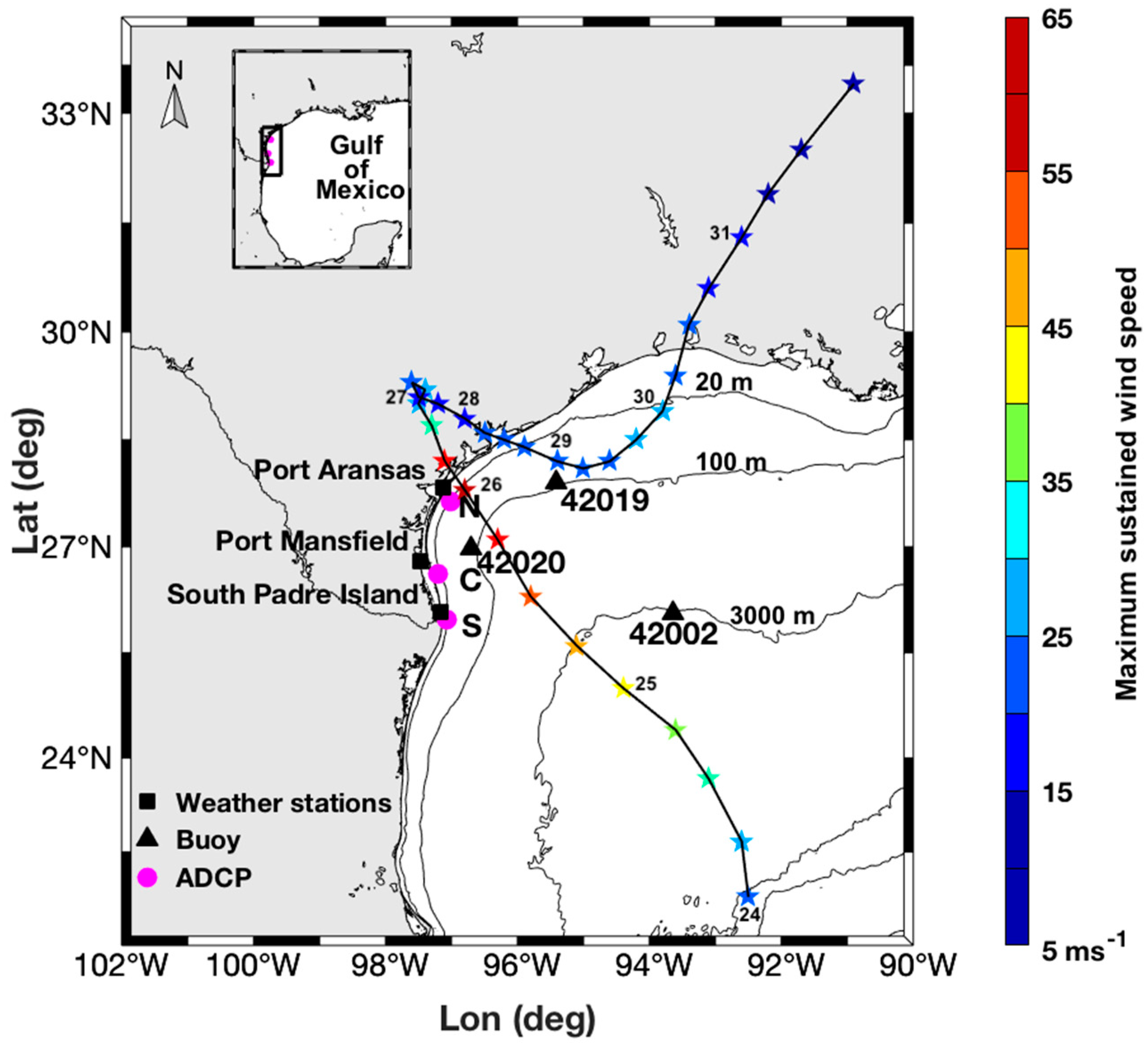

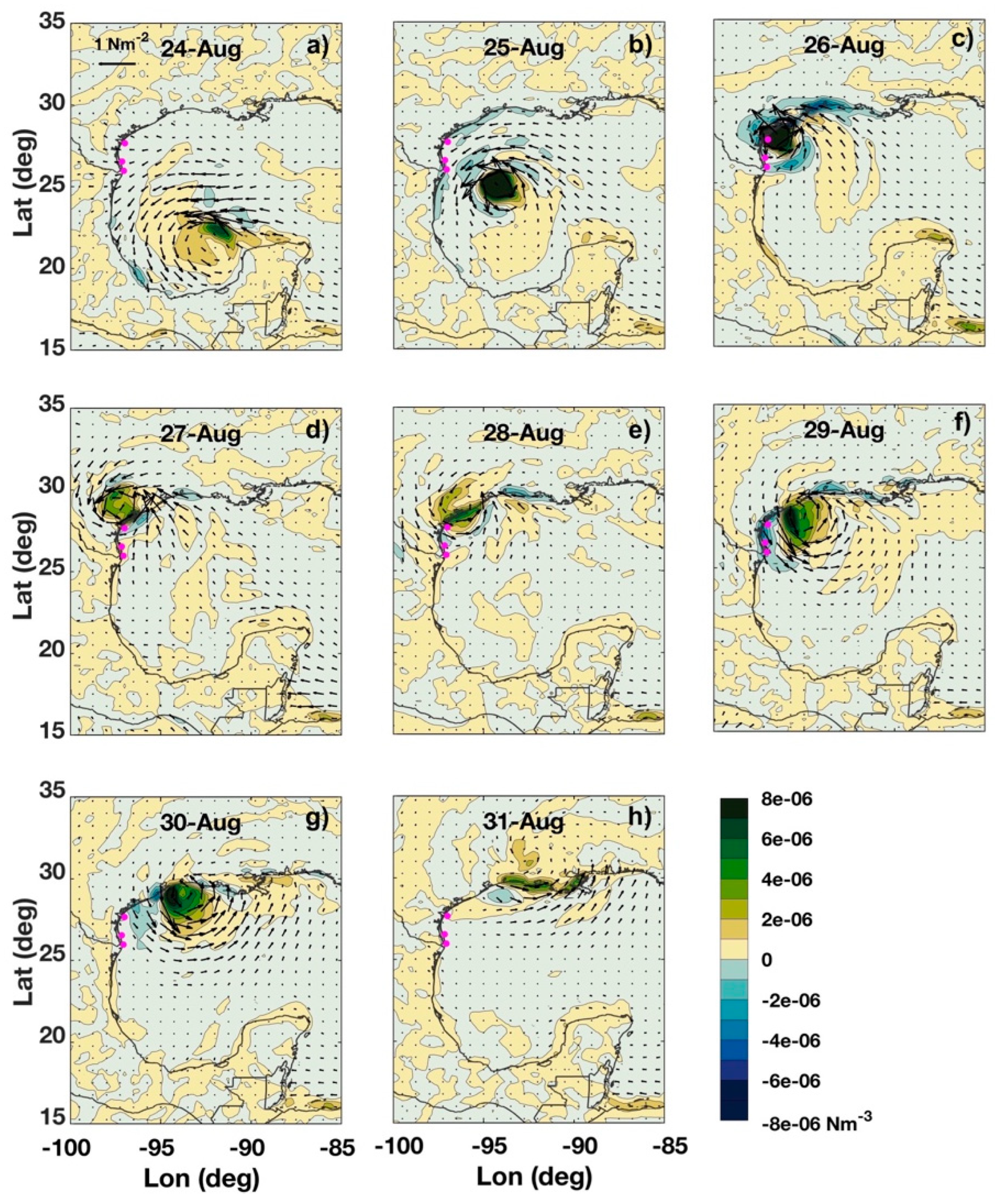



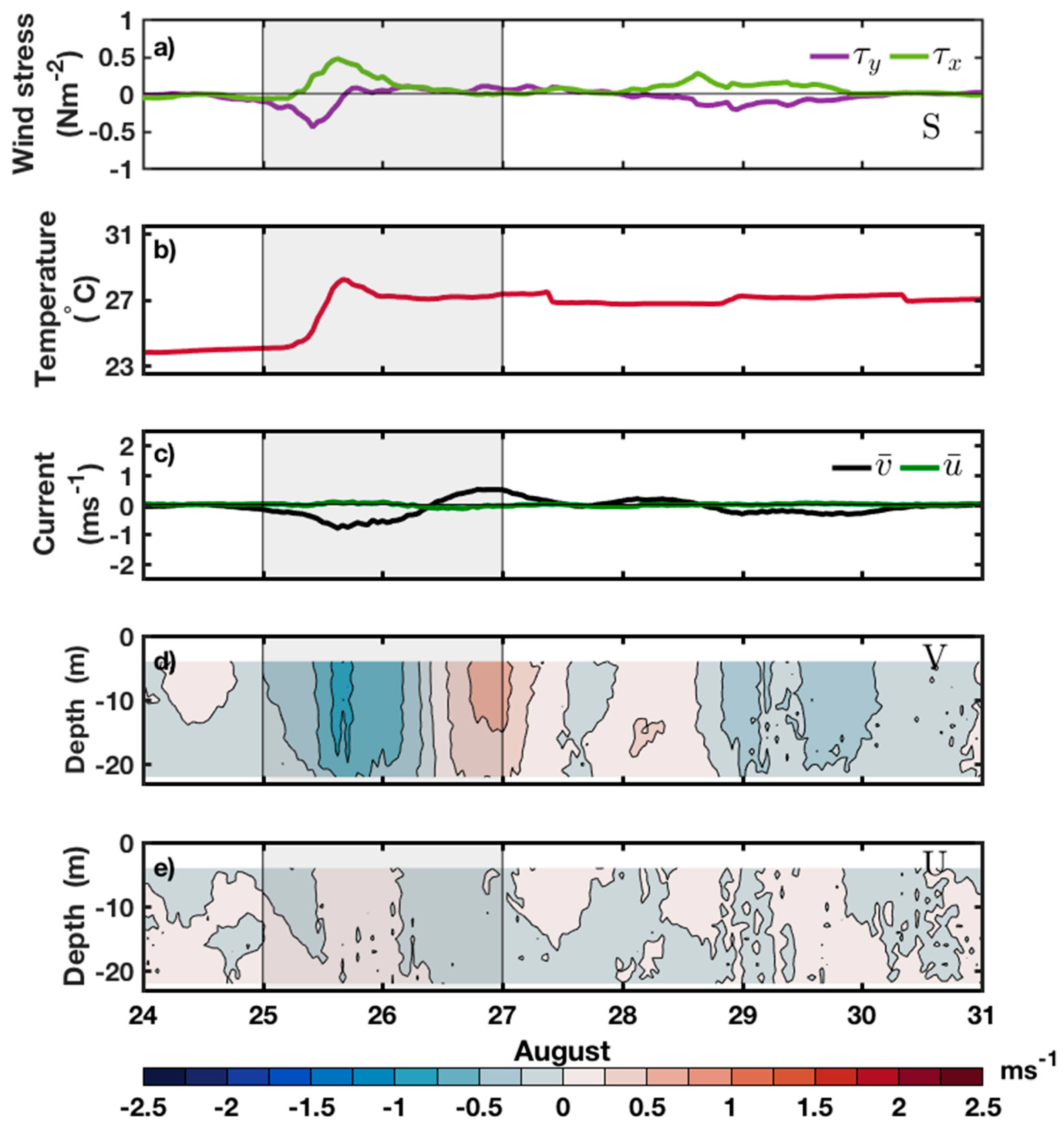
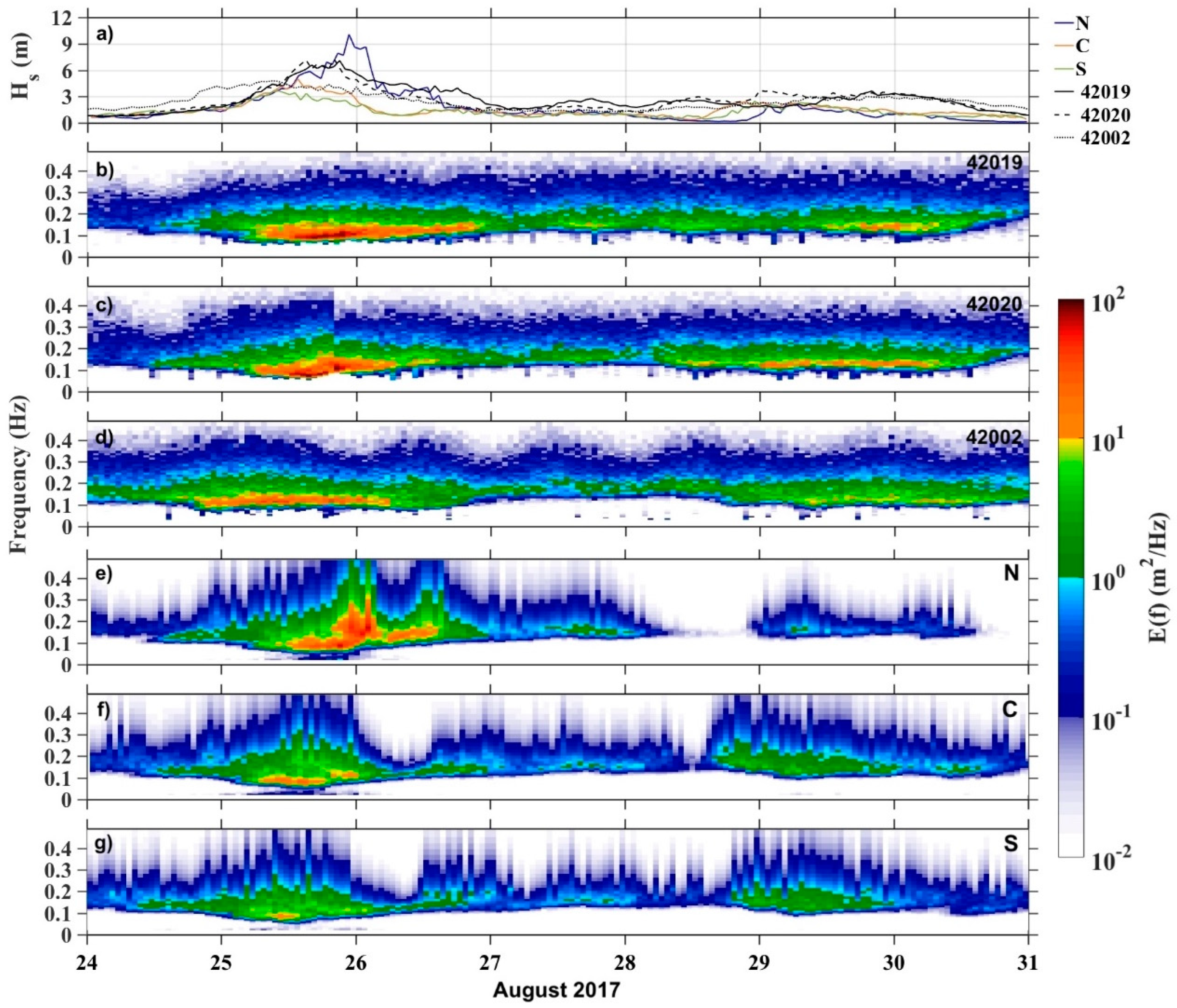
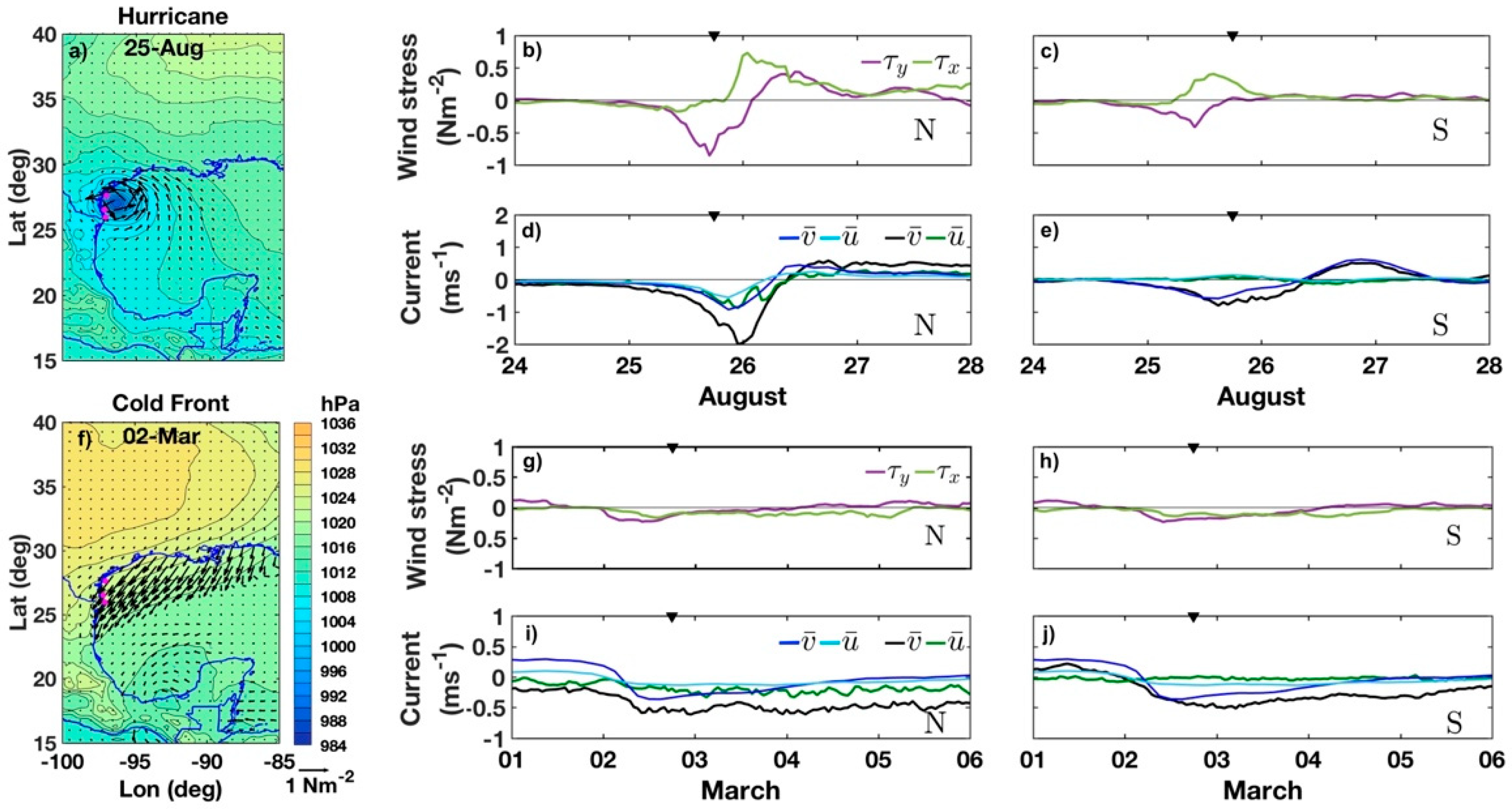


Publisher’s Note: MDPI stays neutral with regard to jurisdictional claims in published maps and institutional affiliations. |
© 2022 by the authors. Licensee MDPI, Basel, Switzerland. This article is an open access article distributed under the terms and conditions of the Creative Commons Attribution (CC BY) license (https://creativecommons.org/licenses/by/4.0/).
Share and Cite
Romero-Arteaga, A.; Ruiz de Alegría-Arzaburu, A.; Esquivel-Trava, B. Spatial Variability of Surface Waves and Nearshore Currents Induced by Hurricane Harvey along the Southern Texas Coast. J. Mar. Sci. Eng. 2022, 10, 1722. https://doi.org/10.3390/jmse10111722
Romero-Arteaga A, Ruiz de Alegría-Arzaburu A, Esquivel-Trava B. Spatial Variability of Surface Waves and Nearshore Currents Induced by Hurricane Harvey along the Southern Texas Coast. Journal of Marine Science and Engineering. 2022; 10(11):1722. https://doi.org/10.3390/jmse10111722
Chicago/Turabian StyleRomero-Arteaga, Angélica, Amaia Ruiz de Alegría-Arzaburu, and Bernardo Esquivel-Trava. 2022. "Spatial Variability of Surface Waves and Nearshore Currents Induced by Hurricane Harvey along the Southern Texas Coast" Journal of Marine Science and Engineering 10, no. 11: 1722. https://doi.org/10.3390/jmse10111722





